Pamukkale, Turkey
Two fascinating sites in Turkey that are part of the UNESCO World Heritage are Pamukkale and Hierapolis. Pamukkale is well-known for the breathtaking white travertine terraces that once supported Hierapolis, a significant center of trade and culture. The name comes from the hot springs, which discharge mineral-rich water onto the landscape below, creating a distinctive structure that resembles a cotton castle.
The travertines at Pamukkale are white as a result of a natural process in which calcite-rich water flows from hot springs and is deposited on the hills below, resulting in these pristine terraces.
Pamukkale travertines are a natural phenomenon that changes over time. Some Pamukkale pools lose water, while others gain it. Despite the fact that much of the water was diverted to the town for human consumption.
In the 1980s, there was a road that brought tourists directly up the slope of the Pamukkale travertines from the town. Fortunately, that road was decommissioned in the 1990s when a series of artificial pools were built in its place. In addition, the local government bulldozed many hotels built directly next to the travertines and turned the area into a park.
The travertines in Pamukkale are similar to a hot spring in that hot thermal water flows down the hill, creating pools that you can bathe in. Other hot springs in the area include Cleopatra's Antique Pool and the Red Springs of Karahayit. Pamukkale means "cotton castle" in Turkish, and it got its name because hot springs released mineral-rich water onto the hilly landscape below over time, forming a unique natural structure that resembles a cotton castle.
Since Pamukkale is extremely crowded in the summer, the best times to visit are in the spring (April through May) and fall (Sep through October), when the weather is pleasant and there are fewer tourists. On the other hand, if you want to avoid the crowds and visit Pamukkale in the summer (Jun - Aug), it is best to arrive as early as you can. Given that we visited Pamukkale at the end of October when the daytime temperature was still very high and the water was warm, spring and fall should still be pleasant times to travel there.
If you visit Pamukkale in the early morning, as we did, be prepared to be cold on your feet because you must walk barefoot over the cold rock. It will take a few minutes if you enter from the side of town to reach the section where the flowing water becomes warmer.
Location: Denizli Province, Southwestern Turkey

















